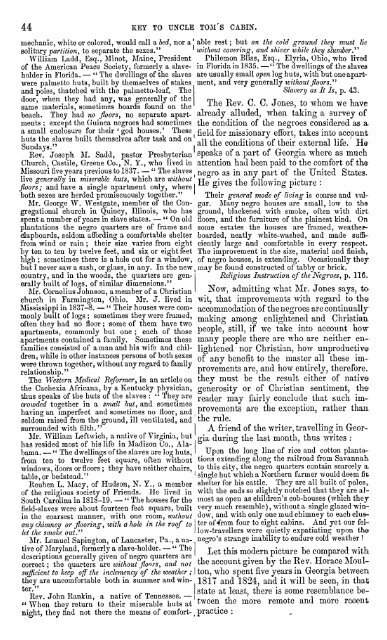UNCLE TOM'S CABIN
1iw97FV
1iw97FV
- No tags were found...
You also want an ePaper? Increase the reach of your titles
YUMPU automatically turns print PDFs into web optimized ePapers that Google loves.
"<br />
"<br />
" When theyreturn to their miserable huts at<br />
night,theyfind not there the means of comfort-<br />
44 KEY TO <strong>UNCLE</strong> TOM S <strong>CABIN</strong>.<br />
mechanic,white or colored,would call a<br />
able<br />
bed,nor a<br />
solitarypartition, to separatethe sexes."<br />
William Ladd, Esq.,Minot, Maine, President<br />
of the American Peace Society, formerly a slaveholder<br />
in Florida in 1835.<br />
"<br />
"<br />
"<br />
in Florida. The dwellings of the slaves<br />
were palmettohuts,built by themselves of stakes<br />
and<br />
and poles țhatched with the palmetto-leaf. The<br />
door, when they had any, was generally of the<br />
same materialsșometimes boards found on the<br />
The Rev. C. C. Jones,to whom we have<br />
beach. They had no floors,no separateapartments<br />
alreadyalluded,when taking a survey of<br />
; except the Guinea negroes<br />
had sometimes the condition of the negroes considered as a<br />
a small enclosure for their ' god houses.' These fieldfor missionary effort, takes into account<br />
huts the slaves built themselves after task and on<br />
allthe conditions of their external life. He<br />
Sundays."<br />
Rev. Joseph M. Sadd, pastor Presbyterian speaks of a part of Georgiawhere as much<br />
Church, Castile, Greene Co., N. Y., who lived in attention had been paidto the comfort of the<br />
Missouri five years previous to 1837- "<br />
" The slaves<br />
livegenerally in miserable negro<br />
huts,which as in any part of the United States.<br />
are without<br />
He gives<br />
floors; and have a singleapartment only, the following picture<br />
where<br />
:<br />
both sexes are herded promiscuously together." Their general mode of livingis coarse and vulgar.<br />
Mr. George W. Westgate, member of the Congregational<br />
Many negro houses are small,low to the<br />
church in Quincy,Illinois, who has ground, blackened with smoke, often with dirt<br />
spent a number of in<br />
"<br />
years<br />
slave states. On old floors, and the furniture of the plainest kind. On<br />
plantations the negro quartersare of frame and some estates the houses are framed, weatherboarded,neatlywhite-washed,and<br />
made sufficiently<br />
clapboards, seldom affording a comfortable shelter<br />
from wind or rain ; their size varies from eight large and comfortable in every respect.<br />
by ten to ten by twelve feet,and six or eight feet The improvement in the size,material and finish,<br />
high; sometimes there is a holecut for a window, of negro houses,is extending.Occasionally they<br />
but I never saw a sash,or glass, in any. In the new<br />
may be found constructed of tabbyor brick.<br />
country, and in the woods, the quarters are generally<br />
Religious Instruction of the Negroes,p. 116.<br />
built of logs, of similar dimensions."<br />
Mr. Cornelius Johnson, a member of a Christian Now, admitting what Mr. Jones says, to<br />
church in Farmington,Ohio. Mr. J. lived in wit, that improvements with regardto the<br />
"<br />
Mississippi in<br />
"<br />
1837-8. Their houses were commonly<br />
accommodation of the negroes<br />
are continually<br />
built of logs; sometimes theywere framed,<br />
making<br />
often they had no floor ; some of them have among enlightened and Christian<br />
two<br />
apartments,commonly but one ; each of those peopleștill, if we take into account how<br />
apartments contained a family. Sometimes these many peoplethere are who are neither enlightened<br />
families consisted of a man and his wife and children,<br />
nor Christian, how unproductive<br />
while in other instances persons of both sexes<br />
of<br />
were thrown together, without any regard to family any<br />
benefit to the master all these improvement<br />
are,<br />
relationship."<br />
and how entirely, therefore,<br />
The Western Medical Reformer,in an articleon theymust be the result either of native<br />
the Cachexia Africana,by a Kentuckyphysician, generosity or of Christian sentimentțhe<br />
thus speaks of the huts of the slaves : " They are<br />
crowded together in a small hut, and sometimes<br />
having an imperfect and sometimes no floor, and<br />
seldom raised from the ground, ill ventilated, and<br />
rest ; but on the cold ground they must lie<br />
without covering, and shiver while they slumber."<br />
Philemon Bliss,Esq., Elyria,Ohio,who lived<br />
"<br />
The dwellings of the slaves<br />
are usually small open loghuts, with but one apartment,<br />
very generally icithout floors.'"<br />
Slaveryas It Is, p. 43.<br />
reader may fairly<br />
are<br />
conclude that such improvement<br />
the exception, rather<br />
the rule.<br />
surrounded with filth."<br />
A friend of the writer,travelling in Georgia<br />
Mr. William Leftwich,a native of Virginia, but during the last month,thus writes :<br />
has resided most of his life in Madison Co., Alabama.<br />
"<br />
The dwellings of the slaves are loghuts, Upon the long line of rice and cotton plantations<br />
from ten to twelve feet square, often without extendingalongthe railroad from Savannah<br />
windows, doors or floors ; theyhave neither chairs,<br />
to this city țhe negro quarters contain scarcelya<br />
table,or bedstead."<br />
singlehut which a Northern farmer would deem fit<br />
Reuben L. Macy, of Hudson, N. Y.<br />
,<br />
a member shelter for his cattle. They are all built of poles,<br />
of the religious societyof Friends. He lived in with the ends so slightlynotched that theyare almost<br />
"<br />
South Carolina in 1818-19. " The houses for the<br />
as open as children's cob-houses (whichthey<br />
field-slaves were about fourteen feet square, built very much resemble) ,<br />
without a singleglazed window,<br />
in the coarsest manner, with one room, without and with only one mud chimneyto each cluster<br />
any chimney or flooring,with a hole in the roof to of^roin four to eight cabins. And yet<br />
our fellow-travel<br />
letthe smoke out."<br />
were quietlyexpatiating upon tho<br />
Mr. Lemuel Sapington, of Lancaster,Pa.,a native<br />
negro'sstrangeinability to endure cold weather !<br />
"<br />
slave-holder."<br />
of The<br />
Maryland,formerlya<br />
Let thismodern picture<br />
descriptions generallygiven of negro quarters be comparedwith<br />
are<br />
correct ; the quarters are without floors, and the account<br />
not<br />
givenby the Rev. Horace Moulton,who<br />
spent five years in Georgiabetween<br />
sufficient to keepoffthe inclemencyof the weather ;<br />
they are uncomfortable both in summer and winter."<br />
1817 and 1824,and it will be seen, in that<br />
state at leastțhere is some resemblance between<br />
"<br />
Rev. John Rankin, a native of Tennessee.<br />
than<br />
the more remote and more recent<br />
practice :




